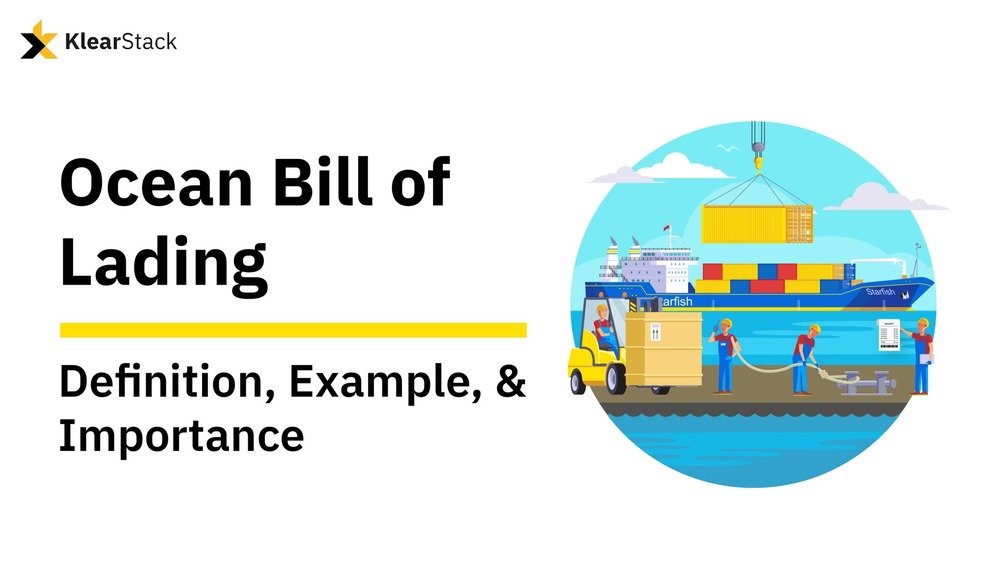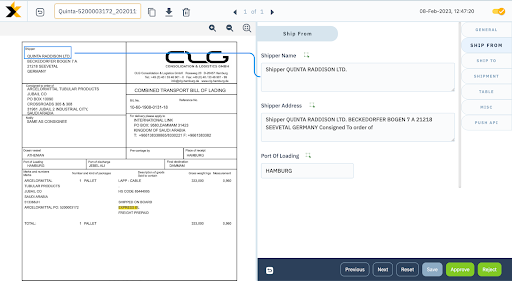
What is an Ocean Bill of Lading?
An Ocean Bill of Lading (OBL) is a legal document required for shipping goods across international waters. It serves three primary roles:
- Receipt of Goods – Confirms that the carrier has received the cargo in good condition.
- Contract of Carriage – Outlines the agreement between the shipper and the carrier.
- Document of Title – Determines who has legal ownership of the cargo during transit.
This document ensures smooth international trade, defining shipment terms, responsibilities, and cost breakdowns between the shipper and the carrier.
Key Information in an Ocean Bill of Lading
| Detail | Description |
|---|
| Shipper | Name, address, and contact details of the sender. |
| Consignee | The receiver of the goods (can be a business or individual). |
| Carrier | The shipping company responsible for transport. |
| Goods Description | Type, quantity, and condition of the items being shipped. |
| Voyage Details | Vessel name, voyage number, and ports of loading/unloading. |
| Freight Charges | Cost of transportation and any additional charges. |
| Incoterms | Specifies shipping responsibility (e.g., FOB, CIF, EXW). |
| Date of Shipment | Confirms when the goods were handed over for transport. |
| Special Instructions | Handling guidelines or delivery requirements. |
The document serves as a receipt, outlining the agreement between the shipper and the carrier for the entire journey, detailing shipment specifics, and acknowledging receipt of the goods.
Ocean Bill of Lading Example
Here’s a sample Ocean Bill of Lading for a shipment from Shanghai to Los Angeles:
Carrier: Pacific Voyager Inc.
Shipper: XYZ Electronics Co., Shanghai, China
Consignee: ABC Retailers Inc., Los Angeles, USA
Goods:
- Smartphones – 100 units
- Laptops – 50 units
- Voyage Number: PV202301
- Ports: Shanghai (Loading) → Los Angeles (Discharge)
- Incoterms: FOB (Free on Board)
- Freight Charges: $10,000 + $500 customs fees
- Special Instructions: Handle with care, direct delivery to ABC Retailers’ warehouse.
Signatures & Carrier Seal Required for Validity
The agreement outlines key details such as:
- Names and details of the shipper, consignee, and carrier.
- Information about the goods – what they are, how much, and their condition.
- Specifics about the sea-based journey, like the ship’s name, voyage number, and the ports involved.
- Terms agreed upon by both parties, along with who is responsible for what.
- A clear breakdown of costs, how much for freight, and any extra charges.
- Locations for picking up and delivering goods, even if they’re in different countries.
- Confirmation of when the carrier received the goods.
Unlike an Inland Bill of Lading, this special document is designed for global shipping, following the rules of international trade.
Ocean Bill of Lading Example Tablular
The following Ocean Bill of Lading documents the agreement for the international sea shipment, providing essential information for a smooth and accountable transportation process from Shanghai to Los Angeles.
Ocean Bill of Lading Example for a Shipment from Shanghai to Los Angeles:
|
[Carrier Logo] [Carrier Name, Inc.] [Carrier Street Address, City] [Carrier Phone, Email, etc.] | ||
|
Shipper: |
XYZ Electronics Co. Shanghai, China Phone: [Shipper Phone], Email: [Shipper Email] | |
|
Consignee: |
ABC Retailers Inc. Los Angeles, USA Phone: [Consignee Phone], Email: [Consignee Email] | |
|
Description of Goods: | Product 1: | Smartphones, 100 units(Including detailed specifications.) |
| Product 2: |
Laptops, 50 units (Including detailed specifications.) | |
|
Voyage Information: | Vessel: | Pacific Voyager |
|
Voyage Number: |
PV202301 | |
| Ports: |
Shanghai (Loading) – Los Angeles (Discharge) | |
|
Date of Shipment: |
[Current Date] | |
|
Terms and Conditions: |
Incoterms 2020: FOB (Free on Board) | |
|
Freight Charges | Freight: | $10,000 USD |
| Additional Charges: |
$500 USD for customs documentation | |
|
Notable or Special Instructions: |
Handle electronic devices with care; delivery to ABC Retailers’ warehouse upon arrival. | |
|
Signature and Seal: | [Signature of Shipper Representative] | |
| [Signature of Carrier Representative] | ||
|
[Carrier Seal] | ||
What is the Purpose of Ocean Bill of Lading?
An Ocean Bill of Lading and an Inland Bill of Lading serve as pivotal documents in goods transportation, yet they diverge in scope and application. The Ocean Bill of Lading is tailored for global trade, adhering to international standards.
In recognizing this, stakeholders can select an appropriate Bill of Lading based on the nature, destination, and mode of transportation.
They may ponder the following queries:
- Is the shipment destined for international trade, involving sea transport across different countries?
- Do the involved parties span international borders, including the shipper, carrier, and consignee?
- Are there specific legal or contractual obligations associated with international shipments that must be considered?
Why is an Ocean Bill of Lading Important?
An Ocean Bill of Lading is crucial for global trade because it:
Ensures Legal Compliance – Meets international trade regulations.
Acts as Proof of Shipment – Protects buyers and sellers.
Facilitates Payments – Used by banks for Letter of Credit transactions.
Enables Cargo Tracking – Details port locations, vessel info, and delivery timelines.
It differs from an Inland Bill of Lading, which is used for domestic shipments by land transport.
Parties Involved in an Ocean Bill of Lading
It is noteworthy that the buyer himself is not directly involved in the issuance of the Ocean Bill of Lading unless he’s the consignee.
The following are the parties involved in an Ocean Bill of Lading:
- Shipper (Consignor): The entity or individual shipping the goods, initiating the shipment process.
- Carrier (Shipping Company): Responsible for physically transporting the goods and issuing the Ocean Bill of Lading.
- Consignee (Receiver): The party or entity to whom the goods are being shipped. The consignee is typically listed on the Ocean Bill of Lading and is entitled to claim the goods upon arrival.
- Notify Party: An optional party named on the bill who is to be notified of the arrival of the goods at the destination.
Types of Ocean Bills of Lading
| Type | Description |
|---|---|
| Straight Bill of Lading | Non-negotiable; only the named consignee can claim the goods. |
| Negotiable Bill of Lading | Transferable; ownership can be passed before delivery. |
| Through Bill of Lading | Covers multiple transport modes (land + sea). |
| Sea Waybill | Used when the title transfer is not needed. |
🔹 Which One to Choose?
If only ocean transport is involved, use a Straight Bill of Lading or Sea Waybill.
If ownership needs to be transferred before arrival, use a Negotiable Bill of Lading.
If goods will move further inland, use a Through Bill of Lading.
When to Consider Other Bills of Lading?
Given the diverse range of bills of lading available—it’s wise to assess the best fit for your trade requirements.
Explore other options if your shipment involves trade within the borders or if you need flexibility in ownership transfer, potentially considering a Negotiable Bill of Lading. For goods with specific conditions, a Claused Bill of Lading may be appropriate. Opt for the Uniform Bill of Lading if you prefer a standardized document format.
Who Issues an Ocean Bill of Lading?
The shipping carrier or their authorized agent issues the Ocean Bill of Lading. The shipper receives it upon cargo handover, and the consignee presents it at the destination port to claim the goods.
Parties Involved
Shipper (Consignor): Sends the goods.
Carrier (Shipping Company): Transports the goods.
Consignee (Receiver): Receives the goods.
Notify Party (Optional): Gets informed upon shipment arrival.
Automate Your Bill of Lading with KlearStack 🚀
Tired of manually processing Bills of Lading?
KlearStack uses AI-driven intelligent document processing (IDP) to automate your Ocean Bill of Lading tasks.
💡 Why Use KlearStack?
No need to manually enter data — KlearStack adapts to any BOL format, eliminating errors and saving hours of work.
Request a FREE KlearStack Demo Today!
Automate Your Bill of Lading with KlearStack. Simplify the Nuances of International Trade Terms Today!
KlearStack is an AI-driven intelligent document processing (IDP) solution that helps you automate your ocean bill-of-lading needs.
KlearStack is a template-free solution, meaning you don’t have to train the model separately for every new Bill of Lading layout. It processes even a completely new layout with significant accuracy. The more documents you process with KlearStack, the smarter it gets because of its adaptive learning capabilities.
The automated tool lets you set up predefined rules & formats to check whether details like names, addresses, and product descriptions are accurate.

With the help of KlearStack, you can–
✓Cut costs upto 70%.
✓Achieve 99% Accuracy.
✓Reduce manual effort upto 90%

FAQs on Ocean Bill of Lading
An Ocean Bill of Lading is a legal contract for international sea shipments, acting as a receipt, shipping agreement, and document of title.
The Ocean Bill of Lading acts as a receipt for shipped goods, a contract between the shipper and the carrier, and a title document, facilitating the international sea transport process and ensuring accountability.
The shipping carrier or freight forwarder issues the document, confirming shipment details and responsibilities.
The key difference lies in scope. An Inland Bill of Lading covers domestic land transport, while an Ocean Bill of Lading is used for international sea shipments, encompassing the entire journey from port to port.



